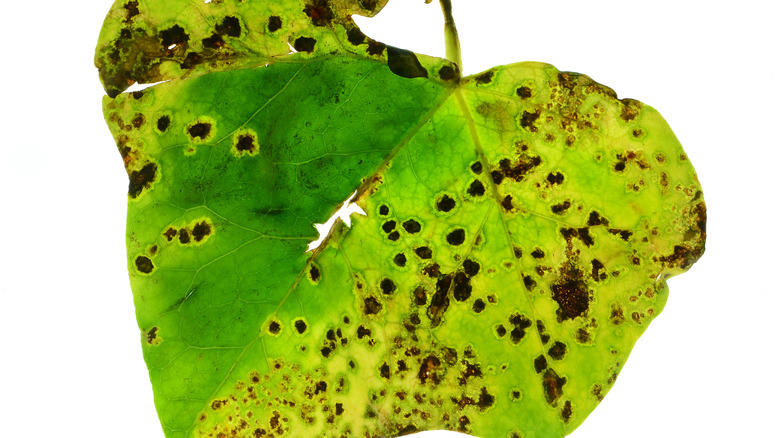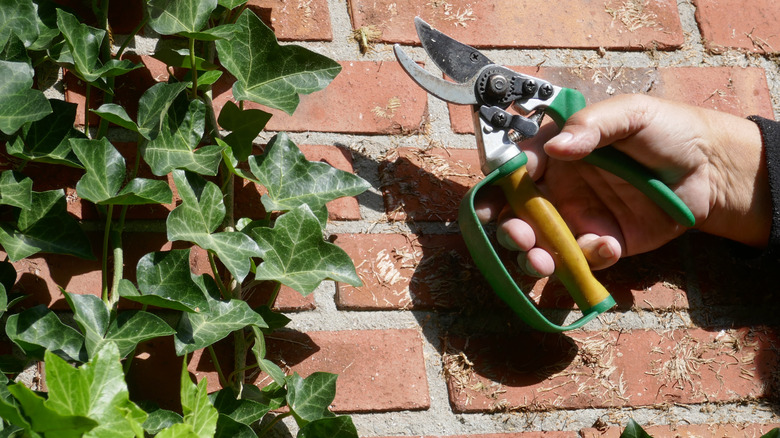English ivy (Hedera helix) is a beautiful ornamental plant that climbs and crawls through gardens without much need for attention. The dark green leaves of this plan, which tend to have lighter and darker spots, contribute to its overall impressive look as it climbs up trellises and over retaining walls. However, if you begin to notice water-like spots on the leaves of this plant, yellowing, and even holes develop, your English ivy may have leaf spot developing — a bacterial disease not uncommon for the plant. Depending on the tip, it may be a fungal infection instead.
To save all of your English ivy, you may have to be aggressive in removing damaged leaves, as there’s no other significant way to stop it from spreading effectively. If left to continue, leaf spot will move from one area of the plant to the next. In some situations, using a fungicide can offer help, especially if you’ve gotten the condition early enough before it significantly spreads. The key to keeping your English ivy alive is to control how you water these plants. The goal is to keep the leaves as dry as possible to minimize the damage brought on by leaf spot. Leaf spot, whether fungal or bacterial in nature, will lead to an infection that causes a leaf petiole, or hole, that will eventually blacken. The infection then continues to move towards the stem, leading to the death of the plant. Both control and prevention are critical.
Controlling English ivy leaf spot

As you care for your garden, look for the early signs of leaf spot. Typically, English ivy has an evergreen, dark coloring without any spotting. If you notice brown or black discoloration circles on the leaves, or the leaves become yellow, that indicates bacterial leaf spot. In contrast, large, irregularly shaped brown discoloration tends to be a fungal leaf spot condition. Also note that if you pick out English ivy from a garden shop, avoid any plants with this type of discoloration on them, as it will spread.
Once you notice either variety of leaf spot, take action. The most effective way to get rid of the disease is to remove any leaves containing obvious damage. Prune these areas, bag them immediately, and transport them out of the area. Don’t toss the infected plants throughout the area since the fungus and bacterial spores will easily germinate in other areas if given the chance. Wait until the plant is dry with no wet areas before removing the infected leaves since the moisture could allow the infection to spread to nearby plants more easily. Make sure to remove all infected areas. That includes both the leaves with spots as well as connected stems. Being more aggressive now in removing any leaves touching the infection can also help. You can also use fungicides to some level of success. Follow all manufacturer guidelines.
Preventing leaf spot is the most important strategy

Once you remove the impacted areas of spot leaf, it’s still likely that the fungus or bacteria will remain. However, with continued use of pruning away diseased areas, you’ll bring it more under control. It’s possible to simply continue that process long-term to keep your English ivy as healthy as possible.
However, the most important way to prevent this condition and minimize its reoccurrence is to change how you water it. Avoid actually watering the plants from above the leaves. Keep the foliage as dry as possible instead. Also, water during the morning hours so there’s ample time for the leaves to fully dry quickly. The bacteria causing this condition (Xanthomonas campestris pv. Hederae) need humidity to thrive. Keeping the plant’s foliage dry protects the small openings it can get into. Also, keep the English ivy properly pruned to allow good airflow under and through the branches. This, too, enables fast drying and less spread.
For an added level of support after removing the fungal or bacteria infection, apply a solution of 10 parts water to 1 part white vinegar to the plant’s surface. Do this during the warm part of the day when there’s plenty of time to dry. This may help minimize some of the remaining fungus on nearby leaves and stems. The vinegar acts as a type of disinfectant to treat the fungus and bacteria.



